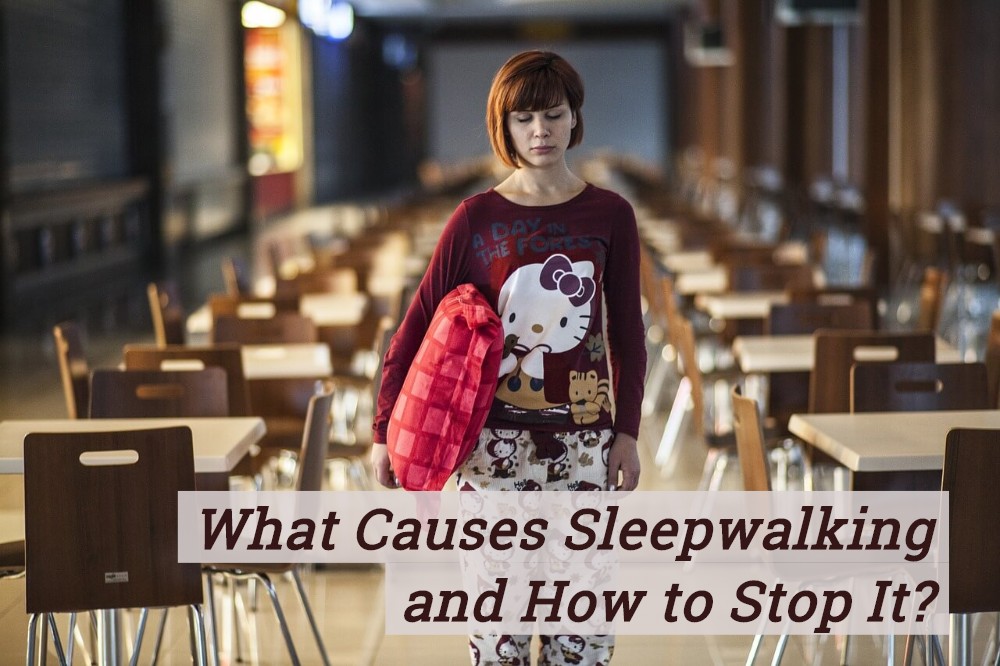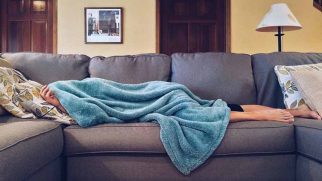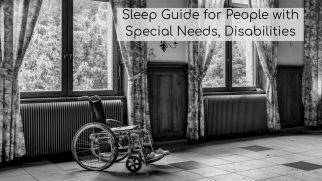What Causes Sleepwalking and How to Stop It?
by | Last Updated
Sleepwalking is one of the most striking sleep disorders today.
And one of the most dangerous too.
Sleepwalkers often may injure themselves by tripping over something or falling from stairs.
The good thing is, this disorder can be treated and alleviated effectively without using medication.
So, if you suspect that you — or someone you know — is a lunatic, check out these simple tips on how to stop sleepwalking.
What Is Sleepwalking and How Common Is It?
To start with, sleepwalking is a parasomnia.
Parasomnias not necessarily are the signs of a sleeping disorder. They are just a phenomenon that happens during sleep.
Simply put, our brain gives the body a command to get up and do something while remaining in the sleeping state.
That is why sleepwalkers often do not react if you ask them to go back to bed.
According to Stanford University studies, 3.6% of Americans are prone to chronic sleepwalking, and about 30% have experienced a sleepwalking episode at least once in their lifetime.
Myths About Sleepwalking You Should Stop Believing
Since sleepwalking is a rather unusual pathology, obviously there are a bunch of myths about it.
Let’s debunk some of them.
- Do not wake a sleepwalker, or else they will die. Probably the most common myth. In fact, the worst thing that can happen is that a person might attack you, as they will be frightened and disoriented because they woke up being outside their bed. The best way to wake the sleepwalker in case of emergency is a loud and sudden sound. In other cases, try to lead them back to bed.
- Sleepwalking episodes decrease with age. People tend to believe that sleepwalking is common in children, but this is only partially true. Among children, almost 17% experience somnambulism, compared to only 4% of adults. However, sleepwalking can be triggered in adulthood too, for example, by abusing alcohol or developing chronic sleep deprivation.
- Sleepwalkers do not remember what happened to them while they were sleeping. Another half-true myth. Again, amnesia is more common in children. In adults, the brain may be in a state of partial awakening, so they can remember some moments from their night journey.
- Sleepwalkers cannot feel pain. It’s not true. Yes, they become indifferent to almost any stimuli, as their brains sleep. But they can still get hurt, and they will wake up if the pain is strong enough.
What Causes Sleepwalking in Adults?
So, why do some people sleep like the dead, while others sleepwalk?
Here are the main causes of somnambulism in adults:
- Stress. If you are constantly stressed out and do not find time to relax, then you may be prone to sleepwalking more than others.
- Sleep deprivation. In some cases, it can also lead to somnambulism.
- Medication. Antipsychotics, tranquilizers, or other drugs that interfere with sleep patterns can often cause sleepwalking episodes.
- Illnesses. Somnambulism can often be a symptom of some sleep-related problems, such as sleep apnea or acid reflux.
- Heredity. If any of your close relatives walk in their sleep, you might have a predisposition too.
Fun fact: Episodes of somnambulism are more likely to happen if a person falls asleep with a full bladder. So, always visit a bathroom before going to bed.
At What Stage of Sleep Does Sleepwalking Occur Most Often?
 Somnambulism is somewhat paradoxical.
Somnambulism is somewhat paradoxical.
The thing is, its episodes usually strike at first two hours after falling asleep.
This is exactly the time when we are in the deep sleep stage.
This stage is characterized by complete relaxation of the body, and the brain at this moment becomes immune to any external influences. However, it still can command your body to get up and go somewhere, which is what most sleepwalkers do.
But that’s not it.
Another typical behavior during sleepwalking episode usually includes:
- mumbling or talking to yourself;
- screaming;
- performing repeated motions, like snapping fingers or rubbing eyes;
- doing weird things, e.g. trying to escape the house by crawling out the window;
Sleepwalking is quite often associated with another parasomnia, sleep eating. This combo might become dangerous, as the somnambulist can easily get poisoned by eating a laundry detergent or other inedible thing.
How to Treat Sleepwalking Effectively?
Proper sleepwalking treatment consists of many factors and sorting them out is easier than it may seem.
Let me elaborate them for you.
Cope with stress
Stress management can not only help you get rid of the episodes of somnambulism but also improve the overall quality of life.
Here’s what you can do for this:
- start a new hobby;
- before going to sleep, take some time to do breathing exercises and wind-down;
- write down your thoughts and worries regularly;
- meditate.
Build healthy sleep patterns
Healthy sleep hygiene will help combat somnambulism.
I suggest you try some of the following ways to improve your sleep:
- try to go to bed and get up at the same time;
- stick to your sleep patterns even on weekends;
- 20-30 minutes prior to sleep, do your relaxing routine: drink tea, take a warm shower and change into your pajamas (if you wear one).
- stop using gadgets one hour before bedtime.
Aromatherapy is another effective way to relax. Lavender, ylang-ylang, passionflower and other essential oils have a pleasant smell and a great soothing effect to help you fall asleep.
Have sex
Seriously.
Besides the fact that it is a form of physical activity, sex additionally contributes to the production of dopamine and oxytocin. The latter is known as the “love hormone”, and it makes you relaxed and helps you fall asleep faster.
Upgrade your bedroom
The bedroom should be a sacred place to sleep. And you can use the following techniques to achieve this:
- get blackout curtains;
- paint walls in calm colors;
- use drapes and carpets to absorb surrounding sounds;
- play white noise during the night.
It’s a good idea to spread out the objects around the bed to block your way if you start walking in your sleep. Thus, you will stumble upon them and wake up. It’s better to choose something big and soft, like pillows or stuffed toys.
Review Medication with Your Clinician
In some cases, medications and supplements can alleviate the symptoms of somnambulism.
But self-medication is not a good thing to do.
Discuss the recommended sleeping aids and their dosage with your therapist to avoid side effects and unpleasant symptoms.
Now, sleepwalking itself is not harmful. But it can put you or your loved ones in rather risky situations. So, arm yourself with these tips to minimize this disorder or even eradicate it completely. And if you have your own working tips, you’re welcome to share your experience in the comments!





No Comments